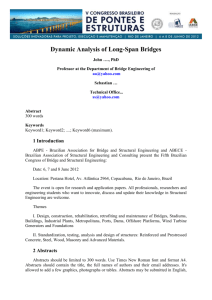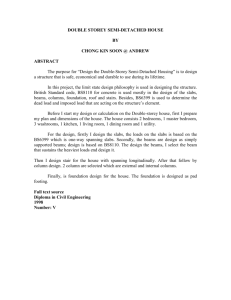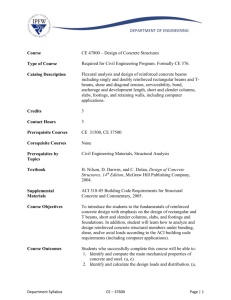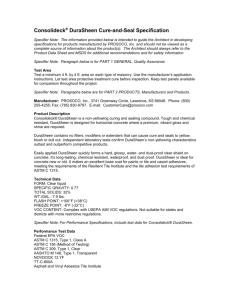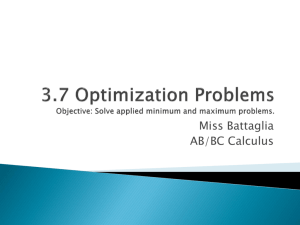strengthening reinforced concrete structures by bonding
advertisement
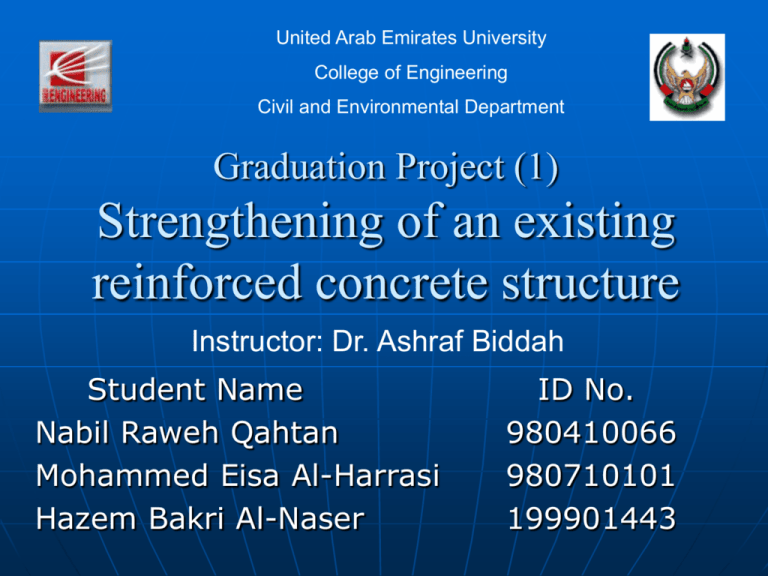
United Arab Emirates University College of Engineering Civil and Environmental Department Graduation Project (1) Strengthening of an existing reinforced concrete structure Instructor: Dr. Ashraf Biddah Student Name Nabil Raweh Qahtan Mohammed Eisa Al-Harrasi Hazem Bakri Al-Naser ID No. 980410066 980710101 199901443 Introduction Exclusive Summary The general idea of the project. Problems Facing reinforced concrete structures. Exclusive Summary The main achievements: Studying the Strengthening Methods. Selection of an exiting building. Experimental Test. Beginning of Structural Analysis. The general idea of the project The owner of a residential building wanted to convert his building to a commercial building. According to change in the use of existing structure, the structural system of the building will be modified to fit the new changes. PROBLEM: The old building cannot carry the new loads that come from the changes. DESIGN BRIEF : Design a strengthening system that can increase the capacity of the existing structural system to be able to carry the new loads that come from the changes. Problems Facing Reinforced Concrete Structures Load increases. Damage to structural parts. Improvements in suitability for use. Modification of structural system. Errors in planning or construction. STRENGTHENING REINFORCED CONCRETE STRUCTURES BY BONDING STEEL PLATES: 1. 2. Strengthening is the process of adding capacity to a member of structure. Attachment of steel to concrete: Adhesive connecting mechanism. Bolting connecting mechanism. Explanatory Sketch Fig. 1 Techniques of plating reinforced concrete beams. STRENGTHENING REINFORCED CONCRETE STRUCTURES BY PRESTRESSING CABLES: Post-tensioning is a technique used to prestress reinforced concrete after concrete is placed. The tensioning provides the member with an immediate and active loadcarrying capability. External Post-tensioned picture The advantages of External Prestressing Ability to restress, destress and exchange any external prestressing cable. Crack free members. Reduce deflection. High fatigue and impact resistance. The Disadvantages of External Prestressing Usually requiring a greater section depth. More exposed to environmental influences (fire, vandalism, aggressive chemicals etc.). Handling of the tensioning devices may be more difficult. High cost. Concrete Jackets (Section Enlargement) Concrete Jackets (Section Enlargement) Enlargement is the placement of additional concrete and reinforcing steel on an existing structural member. Beams, slabs, columns, and walls, if necessary, can be enlarged to add stiffness or load-carrying capacity. Concrete Jackets In most cases, the enlargement must be bonded to the existing concrete to create a monolithic member for additional shear or flexural capacity. Column Compressive strengthening by Section Enlargement •Enlarging the cross section of an existing column will strengthen the column by increasing its load carrying capacity. •A column can be enlarged in various configurations. •The drying shrinkage effects in the concrete used to enlarge the column must be considered. Section Enlargement Method A •In the illustration, Method A will accomplish efficient load transfer if the new portion is cast with a bond breaker between the new and old concrete. •After most of the drying shrinkage has occurred, the ties that link the old and new concrete can be installed. Section Enlargement Method A •The gap between the new portion of the column and the existing member (to be partially supported by this column) can be filled with dry packing material. •This will allow the new material to share its portion of the load. Section Enlargement Methods B & C •When Methods B and C are used, extreme care should be exercised to select concrete mix designs with very low shrinkage rates. •Pre placed aggregate concrete generally offers the lowest drying shrinkage; it is, therefore, an excellent material for column enlargements. Disadvantages of the concrete jackets Increasing the size of the element, which make its usage very limited. Difficult to construct in some active buildings such as hospitals, schools because of the noise of equipments. Needs shuttering, formworks, reinforced steel, concrete, concrete pumps, vibrators, …etc. Fiber Reinforced Polymer Fiber Reinforced Polymer (FRP) FRP is a new class of composite material for the development and repair of new and deteriorating structures in Civil Engineering. Search for alternatives to Steel and alloys to combat the high costs of repair and maintenance of structures damaged by corrosion and heavy use. FRP Laminate Structure • • FRPs are organized in a laminate structure. each lamina (flat layer) contains an arrangement of unidirectional fibers fabrics embedded within a thin layer of light polymer matrix material. FRP consists of two main components: 1.Fibers. 2.Resin or Matrix. FRP Laminate Structure Types of FRP The three main types of fibers used are: • Carbon. • Glass. • Aramid. Suitability of FRP for Uses in Structural Engineering FRP properties and advantages makes it ideal for wide spread applications in construction worldwide. FRP has a few disadvantages. Advantages of FRP: Corrosion Resistance. Lightweight. Ease of installation. Less Finishing. Less maintenance. Ductility of FRP wrapped members improves dramatically. They are ideal for external application. Advantages of FRP They are extremely durable. They are available in various forms: sheets, plates, fabric, etc. They are available in long lengths that eliminates joints and splices. They cure within 24 hours. Versatility. Anti-seismic behavior. Disadvantages of FRP High cost, susceptibility to deformation under long-term loads Temperature and moisture effects, lack of design codes, and most importantly, lack of awareness. Decision Steel plates Concrete jacketing FRP High Corrosion Medium Corrosion Corrosion resistance Low Cost High Cost High Cost High Installation cost High Installation cost Ease of installation. more Maintenance more Maintenance Less Maintenance Heavy Weight Heavy Weight light Weight Introduction M.S.Project gantt chart. Lab tests on FRP material. Cost estimation for G.P.1 M.S. Project Gantt Chart M.S. Project Gantt Chart Experimental lab test on FRP material. The main objective of this experiment was to study the effect of different environments on the behavior of FRP material. Beams Details This experiment consists of 16 beams and 6 cubes. Beams were divided to 4 groups, each group consists of 4 beams with four different reinforcements. Beams dimensions were 10cm x 10cm x 50cm. Minimum reinforcement of one bar with 6mm diameter (1Φ6) was used. Groups Environment Each group was exposed to four different environments as follows: Group 1: o Room temperature with 26 C. Group 2: Hot water tank with 100 % humidity at 45oC. Group 3: Oven (0% humidity) at 45oC. Group 4: Outside exposed to sun radiation and the variation in temperature through the 24 hours. Equipments Digital balance. Molds of beams and cubes. Mixer. Vibrator. Hot water tank. Oven. Cube test machine. Beam test machine. Materials Concrete mix: water, cement, sand, coarse and small aggregates. Plastic sheet. FRP strips. Strain gages. Procedures Steel reinforcements were prepared. Strain gages were fixed on the steel reinforcement. Concrete ingredients were calculated, weighted and mixed using a big mixer. Concrete was poured in the molds of beams and cubes. Concrete was vibrated and covered by plastic sheet. Procedures 3 cubes were tested after 7 days. Concrete beams and cubes were removed from molds and cured in potable water for 14 days. Beams and cubes were exposed to air drying in laboratory. Procedures FRP was applied with layer of epoxy. Beams were exposed to the different environments for 1000 hours. 3 cubes was tested after 28 days. All beams was tested after 1000 hours. Experimental Result Experimental Results Experimental Results Experimental Observations 1. Effect of Fiber Reinforcement Polymer (FRP) on strengthening the beams: One FRP strip increased the beam's capacity by about 100% for all environments. Two strips of FRP increased the beam's capacity by about 200% for all environments. All reinforced beams strengthen with FRP failed on de-bonding of the FRP at the end of strips due to the shear force at this location. Experimental Observations 2. Environmental effect on the beams: The effect of environment on reinforced concrete beams with steel only is negligible. Plain concrete with one strip of FRP (shear force) was affected in hot environments (humid and dry). Where the effect of outdoor and indoor environments was negligible. Experimental Observations The reinforced concrete beams strengthen with FRP; (bond capacity between the FRP and the concrete) was affected in hot and humid environment. Although the FRP in the outdoor environment was subjected to the Ultra Violet during the 1000 hrs exposure, no reduction in the beam capacity was noticed. Cost Estimation Item # Item Description Manufacturers Cost/ unit # units Total Cost Dhs 1 5MM Steel Strain Gages Single INSTALLATION middle east 25 25 625 2 Super Glue 5g Bottle INSTALLATION middle east 22 2 44 3 Fiber Reinforcement Polymer Sika Company strips (Sika Carbodur S type) 75 Dhs/m 7m 525 4 FRP Epoxy normal)(6kg) 25 6 150 5 Reinforcement Steel Bars (#6) 2 12 24 6 Drawings Copying 4 17 68 7 Reinforcement Steel Welding 5/beam 12 60 (Sikadur 30 Sika Company Al-Moazam stores Total Cost = 1496 Dhs (within the budget) Analysis background The most important and most difficult task faced by the structural designer is the accurate estimation of the loads that may be applied to the structure during its life. The next problem is to decide the worst possible combinations of these loads that might occur at one time. Analysis background The loads that will be used in this project are dead and live loads. Dead loads are loads of constant magnitude that remain in one position. Live loads are loads that can change in magnitude and position. Analysis background ACI code (9.2) states that the required ultimate load carrying ability of the member U provided to resist the dead load D and the live load L must at least equal: U = 1.4D + 1.7L Analysis background The Loads carried by the structure are transferred from one structural element to another until it reaches its final destination to the supporting ground. The loads that come from slabs to beams can be estimated according to the slabs design system and the geometry of these slabs. Analysis background In one direction slabs the beam is carrying half of the slab as a rectangular or square shape. In two way slabs the each beam around the slab is carrying triangle or trapezoidal shape of the slab. Prokon Structural Analysis & Design Prokon structural analysis and design is a useful tool for analysis and design of structures. The PROKON suite has two main components: PROKON Calcpad. PROKON analysis and design modules . Prokon Structural Analysis & Design PROKON interface. Prokon Structural Analysis & Design Input parameters. Prokon Structural Analysis & Design Section dimensions. Prokon Structural Analysis & Design Spans lengths. Prokon Structural Analysis & Design Input loads. Prokon Structural Analysis & Design Shear and Moment diagrams. Structural system of the building Area = 750 m2. It consists of two stories. Types of slabs: One way Hurdy slabs, two way hurdy slabs and two way solid slabs. Types of columns: Rectangular and circular. There are projected beams and hidden beams. Structural system of the building The Floor cover = 2 KN/m2. The Live load = 2 KN/m2. Hurdy slab load The unfactored loads calculation of the one way Hurdy slabs. Comparison between hand & Prokon results Hand results: KN KN 0 . 2 m 0 . 8 m 4 m m3 KN Wall weight 5.75 m Self Weight 25 KN KN KN Wu 1.4 ( 5.75 4 ) 13.65 m m m Wu (l ) 2 13.65 (5.2) 2 Mu 46.137 KN .m 8 8 Wu l 13.65 5.2 Vu 35.5 KN 2 2 Comparison between hand results and Prokon results PROKON results: Conclusion It was learned some modern technologies in strengthening concrete structures. It was learned a new computer software program. The a knowledge that we gained from structural analysis and design courses were applied. Conclusion From the experimental results, it was found that the FRP was effected by 20 % in the hot (0% humidity) environment. It was decided to use FRP to strength the building. It was learned how to analyze one way Hurdy slabs and beams. Thank You for Listening
